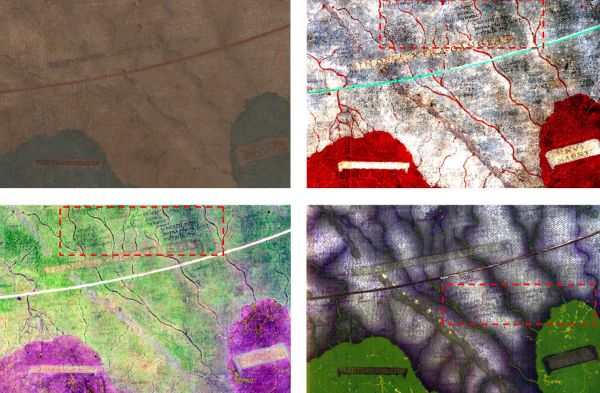Roger EASTON | Chet VAN DUZER | Kevin SACCA
(Rochester Institute of Technology, Rochester, USA)
Keywords: Martellus Map, multispectral imaging, image processing
Abstract:
The c. 1491 world map by Henricus Martellus Germanus, in the collection of the Beinecke Rare Book and Manuscript Library of Yale University, is a very important visual and historical object, being very similar to the c. 1492 globe by Martin Behaim and having significantly influenced the 1507 world map by Martin Waldseemüller. Martellus’ map is painted on paper sheets mounted on canvas and most of the area is covered with text, nearly all of which has faded to the point where it is not readable to the unaided eye. Because of this condition, the map had been little studied, even though it had the promise of yielding significant insight about the geographical knowledge of the time.
The Martellus map was imaged by a team of scientists and scholars in August 2014. Though significant information was recovered during the imaging session, the subsequent spectral image processing required more than a year. Because of the different colors used for both texts and backgrounds (to represent different types of physical features), customized processing methods were necessary to recover many of the writings. From the results, it is estimated that more than 80% of the writings have now been recovered, vs. less than 10% available to the eye from the original map.
This paper will review the processing methods used to recover the texts, including discussions of necessary preprocessing methods to balance the contrast of the text and background, useful segmentation algorithms, as well as postprocessing methods used to enhance the text visibility further.
Relevance for the conference: The variation in coloration of text and background meant that the multispectral image processing had to be customized for individual text blocks.
Relevance for the session: The project successfully recovered most of the text from this little-studied, yet historically significant, object.
Innovation: Text recovery required customized processing to recover texts with very different color contrast.
References:
• Easton, R.L., Jr., W.A. Christens-Barry, and K.T. Knox, Imaging and Image-Processing Techniques, Chapter 5 in The Archimedes Palimpsest, Volume I, Catalogue and Commentary, pp. 175-207, Cambridge University Press, 2011.
• Roger L. Easton, Jr. and David Kelbe, Statistical Processing of Spectral Imagery to Recover Writings from Erased or Damaged Manuscripts, Manuscript Cultures, V. 7, pp. 35-46, 2014.



